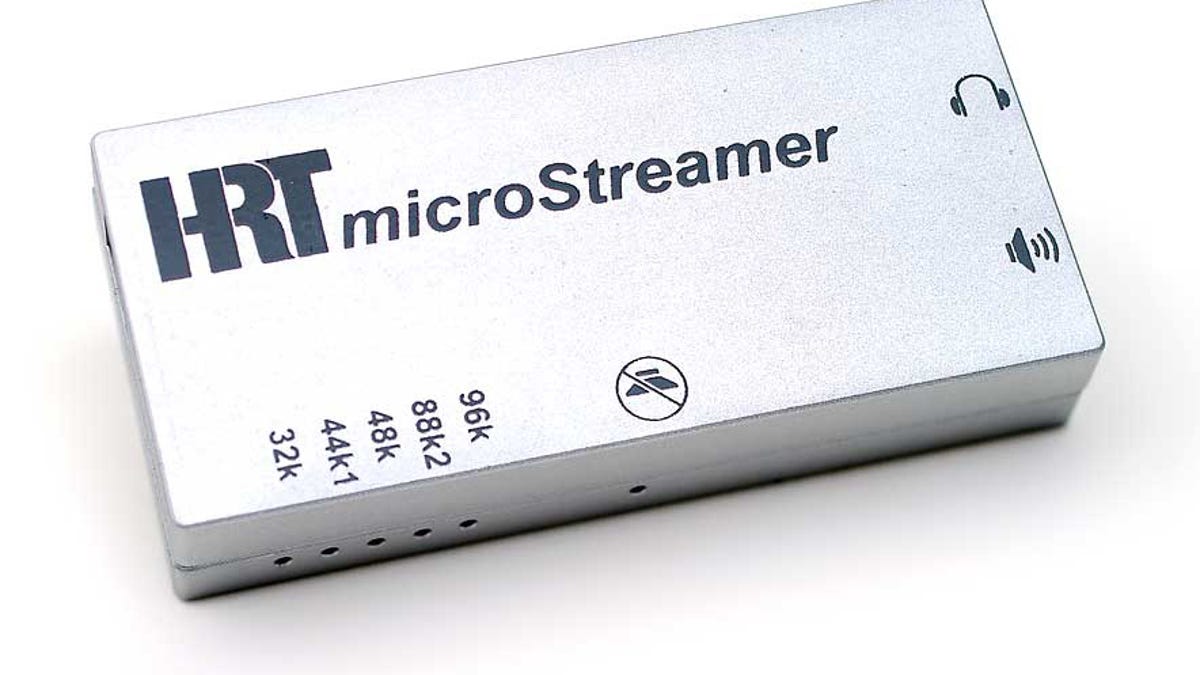A budget-priced, audiophile USB digital converter
The HRT MicroStreamer is a small digital-to-analog converter/headphone amp that sounds great.

High Resolution Technologies makes some of the very best and most affordable digital-to-analog converters on the market. The company's newest model, the MicroStreamer, is a tiny thing, just 2.5 inches by 1.2 inches by 0.4 inch, and since it's USB-powered it doesn't have a power supply or require batteries. It works as an external sound card for computers, tablets, and some smartphones. It's also a high-quality headphone amplifier. It was designed in the U.S., and the little guy's circuitboard's components are mounted in Southern California. The aluminum case is made in China, and the metalwork finishing is done here.
The MicroStreamer has two 3.5mm output jacks, a fixed-level jack that connects your computer and home stereo, or powered loudspeakers; and a variable output headphone jack. The MicroStreamer's two outputs have separate signal paths, digital filters, and amplifier circuits, each one is optimized for its application. Setup is supereasy; just hook up the included USB cable between the MicroStreamer and USB port on the host computer or tablet and select it as the default device. HRT also claims that the MicroStreamer can be used as a USB DAC with Samsung Galaxy S3 (and the upcoming S4) over its MHL connector (contact HRT about the details of that setup). LEDs display the sample rate (32k, 44.1k, 48k, 88.2k, and 96k) of the music being played. As firmware improvements become available, the MicroStreamer can be updated from your desktop.
The MicroStreamer impressed from the get-go; the sound was highly detailed and pure. Compared with the $249 AudioQuest DragonFly USB DAC, the MicroStreamer is a tiny bit bigger. To test the headphone amps, I started with two very different headphones, a high-impedance (300 ohm) Sennheiser HD 580 and a low impedance (35 ohm) Hifiman HE-400; both are full-size headphones. I can't say there were huge sonic differences between the HRT and AudioQuest, even when I played 96-kHz/24-bit high-resolution files. The V-Moda M-100 really sounded great with the MicroStreamer. This headphone model's bass can sound muddy when I play it with my iPod Classic, but the MicroStreamer firmed up the low end, the stereo soundstage was more spacious, and the treble was sweeter, too.
I also tried the MicroStreamer with Ultimate Ears UE 900 in-ear headphones while listening to Jakob Dylan's "Women and Country" album. This recording has a lot of bass, and the MicroStreamer outdid the DragonFly by better clarifying the lowest frequencies. Violinist Joshua Bell's beautifully recorded "Short Trip Home" CD was magnificent with the MicroStreamer and the UE 900. The amplifier was dead quiet and added no noise or hiss to the sound.
I also auditioned the MicroStreamer feeding an amplifier and my desktop speakers, the KEF LS50s. The sound was highly detailed and clean. It's amazing that such a tiny component like this can produce first-rate audiophile sound quality.
The MicroStreamer retails for $189.95; HRT also offers a less expensive USB DAC/headphone amp, the HeadStreamer, for $139.95.

